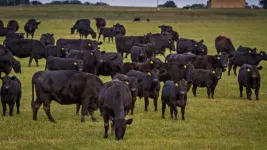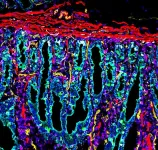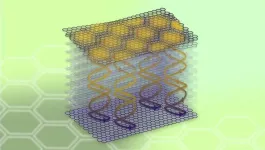(Press-News.org) Ranches across the Show-Me State manage approximately two million cattle — a significant number of which are Angus, a top-tier breed that has unrivaled success in the commercial beef market. In a new study, University of Missouri researcher Jared Decker and Thompson Research Farm tested a group of commercial Angus cows using a commercial genomic prediction tool called Zoetis GeneMax Advantage to investigate the ability of the test to predict their calves’ performance and profitability. This project demonstrates an important step forward in helping inform the selective breeding of commercial cowherds and giving Missouri cattle producers a competitive market advantage.
While testing a sample of commercial Angus females and their offspring at MU’s Thompson Research Farm, Decker found significant relationships between the cows’ genetic merit and the performance of their calves. For the study, researchers focused on specific traits, such as weaning and carcass weight, marbling, fat, and ribeye area.
“In prioritizing the use of this technology, Thompson Research Farm recently harvested a set of 35 steers, 70% of which graded prime, the highest quality grade that the Department of Agriculture (USDA) ranks meat,” said Decker, Wurdack Chair of Animal Genomics in the College of Agriculture, Food and Natural Resources. “Compared to the industry, which grades Prime at a rate of 6%, this is really excellent.”
Decker believes this success stems from the technology that makes genomic predictions possible. In practice, DNA testing allows farmers to select better cows and refine the herd with good genetics on top of good management. As a specialist in the ways technology can streamline farming practices, Decker sees it as his calling to help producers corner the market.
“It’s a goal of mine to help producers innovate in ways that get them closer to harnessing a competitive advantage in this market,” Decker said. “I want to help them adopt new technologies like DNA testing and genomic prediction. For a while now, we’ve had historical data on the performance of calves in terms of growth and carcass performance. So, a key goal of this study was to demonstrate to farmers, ranchers, extension professionals, veterinarians and academics that this technology does, in fact, work. There is a significant relationship between calf performance and the cow's genetic merit.”
Although genomic prediction has a legacy of success in seedstock cattle — purebred animals with documented pedigrees — this is the first time it’s shown to work in a sample of commercial cattle.
For Missouri’s beef industry, a leading driver of state revenue, genomic prediction technology represents an opportunity for growth, both for producers and the economy.
“Genomic prediction tools allow farmers to go from not knowing the pedigree or any of the animal’s performance data to taking a DNA sample and receiving a very accurate prediction as to the heifer’s genetic merit,” said Decker, explaining that this technology opens doors for commercial producers to be more aggressive in selecting the right females to go back into the herd. “This gives farmers a chance to make informed decisions that enhance sustainable profitability.”
For family run farms, genomic prediction technology is not only affordable, but also provides opportunities for small operations to document calf crops that boast superior genetic score cards. This allows farmers to either hold on to the calves through their feeding period and make a greater profit off their carcass merit or to market the weaned calf at a premium based on their first-rate genetics, instead of at typical commodity prices.
“Farmers and ranchers really value this lifestyle; they value the family tradition,” Decker said. “That family tradition gives them the grit and the fortitude to deal with really challenging circumstances like drought or low prices or whatever the present big challenge is. So, helping them think strategically about how to create the best calf crop is something that will serve them and keep those family farms profitable.”
“Evaluation of Zoetis GeneMax Advantage genomic predictions in commercial Bos taurus Angus cattle” was published in Livestock Science. Co-authors include Brian C. Arisman, Troy N. Rowan, Jordan M. Thomas, Harly J. Durbin, William R. Lamberson and David J. Patterson.
END
New study uses gene prediction tool to select premium grade Angus herds in Missouri and across the United States
In his latest research study, University of Missouri’s Jared Decker proves a new genomic prediction tool can help select best-in-class commercial cattle for superior breeding characteristics.
2023-07-19
ELSE PRESS RELEASES FROM THIS DATE:
Tracing maternal behavior to brain immune function
2023-07-19
COLUMBUS, Ohio – Immune system changes in the pregnant body that protect the fetus appear to extend to the brain, where a decrease in immune cells late in gestation may factor into the onset of maternal behavior, new research in rats suggests.
In adult female rats that had never given birth – which typically don’t like being around babies – depletion of these cells sped up their care for rat newborns that were placed in their cage.
The loss of these cells, called microglia, and the related uptick in motherly attentiveness were also associated with changes to neuron activity in several regions of the rat brain, suggesting ...
Stanford Medicine researchers map morphing placenta
2023-07-19
Early in pregnancy, something strange happens in the uterus: Cells from the fetal side of the developing placenta invade the uterine endometrium and work with the mother’s immune system to remodel the arteries.
“When I first read about it, I thought, ‘This is so bizarre,’” said Stanford Medicine pathologist Michael Angelo, MD, PhD.
Humans’ immune systems usually attack unfamiliar cells, which would theoretically pose a problem for a developing pregnancy. But on the mother’s side of the growing placenta, the arteries incorporate cells that genetically match the embryo, just one of ...
It’s a beautiful day in the intestinal neighborhood
2023-07-19
When you think about your ideal neighborhood, perhaps you think of tree-lined streets or a close-knit community of people who help each other. You probably don’t think about your digestive system.
But maybe you should. According to a team of scientists led by researchers at Stanford Medicine, there are indeed “neighborhoods” of different cell types cooperating to digest your food and protect you from infection, among other things — and a new, ultra-high-resolution map of these neighborhoods proves your intestine is both functionally impressive and visually striking.
Just like human neighborhoods, ...
UTHealth Houston study on seasonality of teen suicidality in JAMA Network Open
2023-07-19
The incidences of teen suicidality including self-harm, suicidal ideation, and suicide attempts increased nationally between 2016 and 2021; were at seasonal high peaks in April and October; and were at their lowest when schools were shut down during the COVID-19 pandemic, according to research at UTHealth Houston.
The study was published this month in JAMA Network Open. It was authored by Youngran Kim, PhD, assistant professor in the Department of Management, Policy, and Community Health at UTHealth Houston School of Public Health; Scott D. Lane, PhD, professor and vice chair for research in the Louis A. Faillace, MD, Department of Psychiatry and Behavioral ...
NASA funds 3 citizen science projects to study 2024 U.S. solar eclipse
2023-07-19
NASA has awarded funding for three science teams to conduct citizen science investigations as a total solar eclipse sweeps across North America on April 8, 2024. In these experiments, volunteers will help study the Sun and its ethereal outer atmosphere, called the corona, which is revealed when the Moon completely covers the Sun’s bright disk.
“During next year’s total eclipse, hundreds of volunteers will capture images of the Sun and its corona to help answer real science question about our star and how it affects us,” said program scientist and eclipse lead at NASA Headquarters, ...
Association between markers of structural racism and mass shooting events in major US cities
2023-07-19
About The Study: This study found that major U.S. cities with higher populations of Black individuals are more likely to be affected by mass shooting events, suggesting that structural racism may have a role in their incidence. Public health initiatives aiming to prevent mass shooting events should target factors associated with structural racism to address gun violence.
Authors: Michael Ghio, M.D., of Tulane University in New Orleans, is the corresponding author.
To access the embargoed study: Visit our For The Media website at this link https://media.jamanetwork.com/
(doi:10.1001/jamasurg.2023.2846)
Editor’s ...
Trends, seasonality of emergency department visits, hospitalizations for suicidality among children and adolescents
2023-07-19
About The Study: The findings of this study of 73,000 emergency department visits and hospitalizations for suicidality indicated the presence of seasonal patterns and an observed unexpected decrease in suicidality among children and adolescents after COVID-19–related school closures in March 2020, which suggest a potential association between suicidality and the school calendar.
Authors: Scott D. Lane, Ph.D., of the University of Texas Health Science Center at Houston, is the corresponding author.
To access the embargoed study: Visit ...
Two-faced star exposed
2023-07-19
In a first for white dwarfs, the burnt-out cores of dead stars, astronomers have discovered that at least one member of this cosmic family is two faced. One side of the white dwarf is composed of hydrogen, while the other is made up of helium.
“The surface of the white dwarf completely changes from one side to the other,” says Ilaria Caiazzo, a postdoctoral scholar at Caltech who leads a new study on the findings in the journal Nature. “When I show the observations to people, they are blown away.”
White dwarfs are the scalding remains of stars that were once like our sun. As the ...
Researchers put a new twist on graphite
2023-07-19
FROM: James Urton
University of Washington
206-543-2580
jurton@uw.edu
(Note: researcher contact information at the end)
Embargoed by Nature
For public release at 11 a.m. Eastern Time (8 a.m. Pacific Time; 4 p.m. British Summer Time) on Wednesday, July 19, 2023
Researchers put a new twist on graphite
For decades, scientists have been probing the potential of two-dimensional materials to transform our world. 2D materials are only a single layer of atoms thick. Within them, subatomic particles like electrons can only move in two dimensions. This simple restriction can trigger unusual electron behavior, ...
Understanding the many different ways animals are evolving in response to fire could help conservation efforts
2023-07-19
In our modern era of larger, more destructive, and longer-lasting fires—called the Pyrocene—plants and animals are evolving quickly to survive. By synthesizing the wide body of research about rapid animal evolution in response to fire in a review publishing in Trends in Ecology & Evolution on July 19, a multidisciplinary team of ecology experts hopes to leverage what we already know to help foster evolution-informed conservation plans. In this way, they suggest, we can try to harness the ways in which fire impacts animals to protect vulnerable species—working with evolution instead of against it.
In response to climate change and changes in land use, ...
LAST 30 PRESS RELEASES:
Making lighter work of calculating fluid and heat flow
Normalizing blood sugar can halve heart attack risk
Lowering blood sugar cuts heart attack risk in people with prediabetes
Study links genetic variants to risk of blinding eye disease in premature infants
Non-opioid ‘pain sponge’ therapy halts cartilage degeneration and relieves chronic pain
AI can pick up cultural values by mimicking how kids learn
China’s ecological redlines offer fast track to 30 x 30 global conservation goal
Invisible indoor threats: emerging household contaminants and their growing risks to human health
Adding antibody treatment to chemo boosts outcomes for children with rare cancer
Germline pathogenic variants among women without a history of breast cancer
Tanning beds triple melanoma risk, potentially causing broad DNA damage
Unique bond identified as key to viral infection speed
Indoor tanning makes youthful skin much older on a genetic level
Mouse model sheds new light on the causes and potential solutions to human GI problems linked to muscular dystrophy
The Journal of Nuclear Medicine ahead-of-print tip sheet: December 12, 2025
Smarter tools for peering into the microscopic world
Applications open for funding to conduct research in the Kinsey Institute archives
Global measure underestimates the severity of food insecurity
Child survivors of critical illness are missing out on timely follow up care
Risk-based vs annual breast cancer screening / the WISDOM randomized clinical trial
University of Toronto launches Electric Vehicle Innovation Ontario to accelerate advanced EV technologies and build Canada’s innovation advantage
Early relapse predicts poor outcomes in aggressive blood cancer
American College of Lifestyle Medicine applauds two CMS models aligned with lifestyle medicine practice and reimbursement
Clinical trial finds cannabis use not a barrier to quitting nicotine vaping
Supplemental nutrition assistance program policies and food insecurity
Switching immune cells to “night mode” could limit damage after a heart attack, study suggests
URI-based Global RIghts Project report spotlights continued troubling trends in worldwide inhumane treatment
Neutrophils are less aggressive at night, explaining why nighttime heart attacks cause less damage than daytime events
Menopausal hormone therapy may not pose breast cancer risk for women with BRCA mutations
Mobile health tool may improve quality of life for adolescent and young adult breast cancer survivors
[Press-News.org] New study uses gene prediction tool to select premium grade Angus herds in Missouri and across the United StatesIn his latest research study, University of Missouri’s Jared Decker proves a new genomic prediction tool can help select best-in-class commercial cattle for superior breeding characteristics.






